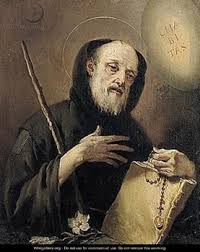Were this not Tuesday of Easter Octave, this April the second would mark the memorial of Saint Francis of Paola (+1507), founder of the ‘Minim’ friars, so called for their humility and poverty, who interpreted the rule of Saint Francis of Assisi in quite a literal sense, extreme poverty, trust in God, foregoing all animal and animal-derived products – true vegans for God! But Francis did so for spiritual, ascetic and redemptive reasons, which makes all the difference.
His parents had conceived Francis of Paola by the original Saint Francis’ intercession, and later healed in a similar manner – hence, his name – and his love for life and all God’s creatures was legendary, even raising, apparently, a half-eaten fish and fully eaten lamb to life. Like many of those saints who practised what seem to our eyes extreme mortifications, Francis’ thaumaturgic life was filled with miracles – often a charism of ascetics and mystics, signifying their deep, liminal connection with the divine – healings and raisings from the dead, foretelling the future, including his own death on this day in his 91st year, on Good Friday that year, while he had the Passion according to Saint John read to him. In 1562, five decades after his death, a group of Huguenots opened his tomb and, finding his body incorrupt something inconvenient to their own ‘narrative’, dragged it out, burned it, and scattered the bones. Catholics recovered these precious relics, and blessed is the reader if he manages to venerate one.
The Order, a radical reform of the Franciscans, founded by Saint Francis of Paola was approved by two Popes, Alexander VI and Julius II, both worldly and immersed in the politics of their day. The former was one of the Borgia popes, who had the Dominican preacher and prophet Savonarola put to death (see the intriguing account of their conflict in the The Meddlesome Friar and the Wayward Pope by Michael de la Bedoyere (1958)). While the latter Pontiff, Julius II, would lead his own papal troops into battle, fully clad in armour. Julius began the re-construction of Saint Peter’s basilica, and his own struggle with the headstrong artist Michaelangelo is recounted in the 1965 film The Agony and the Ecstasy, with Charlton Heston and Rex Harrison. We may suppose the two worldly popes saw something in this decidedly unworldly friar, and the way of life he inspired, quite unlike their own. But, then, the Catholic Church is a big tent, and all sorts jostle therein.
He never allowed himself to be troubled by the flotsam and jetsam of this passing world. As he wrote to his brethren:
Brothers, I most strongly urge you to work for the salvation of your souls with prudence and diligence. Death is certain, and life is short and vanishes like smoke. Therefore you must fix your minds on the passion of our Lord Jesus Christ, who so burned with love for us that he came down from heaven to redeem us. For our sakes he suffered all the agonies of body and mind, and did not shrink from any torment. He gave us a perfect example of patience and love. For our part, we too must be patient when things go against us.
Francis was never ordained a priest, unlike most founders of religious orders. Like his namesake of Assisi) he kept himself far removed from these intrigues, spending most of his life in prayer and good works in his beloved Italia – a fitting intercessor for that beleaguered nation. Towards the end, at the direct order of the Pope, the humble friar spent his final days advising the King of France, Louis XI, as well as the young Dauphin, Charles VIII. On his way to Paris from the Mediterranean coast, Francis healed many, including scores of those afflicted with the plague. Again, a double intercessor for our times.
In one incident, Francis used his cloak to ‘float’ cross a body of water – it seems the coat was both a boat and a sail – when the boatman refused him passage, a feat commemorated in the second of Franz Liszt’s Legendes for piano, ‘Saint Francois de Paule marchant sur les flots’, a sort of miracle for the piano itself, as is much of Liszt’s music.
Life is full of such miracles, if we had but eyes to see, and ears to hear…
Today is the 19th anniversary of the death of Pope Saint John Paul II, who displayed in his final years, months and especially days his truly heroic soul, as well as the value, even the joy, of redemptive and ‘salvific suffering’ (Salvifici Doloris) on which he had written so eloquently in 1984, on the feast of Our Lady of Lourdes. Well, well worth a Lenten read, or re-read, even if you just read my inferior summary of the Holy Father’s reflections.
Prayers for one and all as we rejoice in these days of light and grace of Easter and the Resurrection. Christus resurrexit vere, alleluia! +
(source: wikipedia.org)

